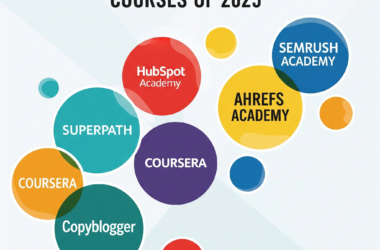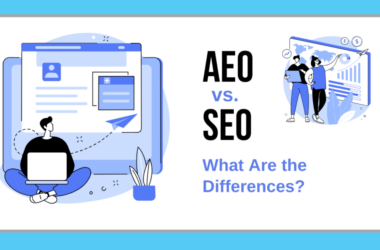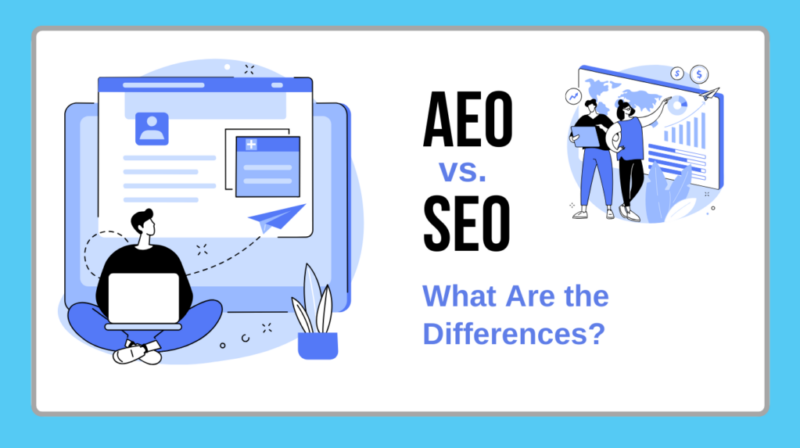Last updated on July 15th, 2025
Organizations and brands are always pursuing new ways to reach their desired audiences. Many organizations have relied on search engine optimization (SEO) for many years now. SEO has played a foundational role in online visibility. Google uses over 200 factors in its algorithm for ranking websites.
With the massive surge in AI and conversational interfaces, we could potentially have a newer entry: answer engine optimization (AEO). Both SEO and AEO may have the same goal of increasing online visibility, but there are clear differences in their function, purpose, and, ultimately, how they envision digital marketing going forward. SEO vs. AEO, therefore, is no longer optional but essential if you want to be able to scale exponentially in 2025 and beyond.

Table of Contents
- The Foundation: Understanding SEO
- The Evolution: Introducing AEO
- SEO vs. AEO: Top 5 Key Differences
- Primary Objective
- Content Focus and Structure
- User Interaction and Engagement
- Optimization Methods and Technical Implementation
- Traffic Impact and Metrics
- The Future: A Symbiotic Relationship
The Foundation: Understanding SEO
SEO, or Search Engine Optimization, is a complete practice that helps improve the visibility and ranking of your site in the organic results pages for a search engine. Normally, this consists of search engines like Google, Bing, and Yahoo, but it can also apply to sites like Yelp or Amazon. The goal of an SEO strategy is to bring organic traffic to your site and entice users to click on your site and explore content.

SEO benefits are manifold and have been proven over the years of digital marketing evolution:
- Increased Visibility and Rankings: The primary advantage of SEO is that it’s essentially about making it easier for potential customers to find your business. And getting higher rankings on SERPs leads to greater visibility.
For example, strong SEO for “unique silver necklaces” would help get your product pages to appear higher in organic Google search results.
- Driving Organic Traffic: SEO attracts visitors who are actively looking for information, products, or services that your business provides. This “pull” marketing usually results in higher-quality leads and more conversions.
Consider a person searching “best hiking trails near Bangalore”. If your travel blog ranks high in search results, visitors already have an affinity for hiking.
- Enhanced Brand Trust and Credibility: When your site ranks highly in organic search results, those users will perceive your site as trustworthy and authoritative. Google prioritizes this perception with its E-E-A-T (Experience, Expertise, Authoritativeness, Trustworthiness) guidelines. A financial advice site that is consistently ranking for “diversified portfolio strategies” is generating a large amount of trust.
- Cost-Effectiveness and Long-Term Results: In contrast to paid ads, SEO provides long-lasting, compounding benefits. Once you rank, your content can continue attracting organic traffic without any direct per-click costs. A local bakery optimized for “custom birthday cakes in Kolkata” can receive inquiries for years.
SEO strategies are made up of several tactics like keyword analysis, on-page optimization (titles, headings, content quality, internal linking), off-page SEO (backlinks, citations), and technical SEO (site speed, mobile responsiveness, crawlability).
The goals are about giving your audience full content coverage with a lot of keywords so they can explore the website with good user intent.
The Evolution: Introducing AEO
Answer Engine Optimization (AEO) is a new strategy that is emerging rapidly, focused on optimizing content to provide quick, direct answers to user requests, especially in relation to artificial intelligence platforms and “zero-click” search results.

Examples of such platforms are voice assistants like Siri and Alexa, AI Chatbots, and Google’s similar search results like Featured Snippets, Knowledge Panels, and Google Overviews. The fundamental purpose of AEO is to provide information right away and right to the user without the user actually needing to be sent to a full webpage.
As developers began using ChatGPT to get code answers straight from AI, Stack Overflow saw an 18% decrease in traffic. However, by making sure their content and brand knowledge continued to reach customers through snippets and other channels, NerdWallet recorded a 35% increase in revenue despite a 20% drop in site traffic.
| Pro Tip: Beyond traditional keyword research, identify common questions and conversational queries related to your industry that are likely to be answered by AI. Use tools that analyze voice search patterns and the “People Also Ask” sections on Google. |
AEO benefits are becoming increasingly critical in the current digital climate:
- Enhanced Visibility in Zero-Click Searches: With the rise of AI-powered summaries and voice searches, many user queries are answered directly on the SERP or through an AI assistant, eliminating the need for a click. AEO ensures your content is positioned to be that direct answer.
If a user asks Google Assistant, “What’s the capital of West Bengal?” an AEO-optimized piece might be the source for the answer (“Kolkata”).
- Improved User Experience with Instant Answers: Users are getting used to getting information quickly and easily. AEO steps in and gives users the opportunity to get relevant and precise information super quickly.
For instance, if I asked Alexa: “How do I make a perfect cup of chai?” An AEO-optimized recipe could deliver the perfect step-by-step summary.
- Increased Authority and Trust: When your content is consistently chosen as the direct answer by AI systems, it establishes your brand as an authoritative source. If your health blog frequently provides the direct answer for “symptoms of common cold” in Google’s AI Overview, your brand’s credibility grows.
AEO tactics involve formatting content so that AI models can easily consume it. This means often using clear and concise text, a frequently asked questions (FAQ) page, lists, tables, and effectively using structured data (schema markup). The emphasis is placed on answering very specific, sometimes conversational questions instead of broad keywords.
SEO vs. AEO: Top 5 Key Differences
While both SEO and AEO aim for online visibility, their fundamental approaches and goals diverge significantly. Here are the top 5 key differences:
- Primary Objective:
- SEO: Increase organic traffic to your website by getting better ranks on traditional SERPs and offering the opportunity to click through to your website.
For example, an online clothing retailer can optimize for “women’s summer dresses” to get users to click on their women’s dresses product category page.
- AEO: The function is to provide real-time, immediate, and concise answers to a user query, largely within AI-improved search experiences (featured snippets, voice assistants, AI chatbots) — and typically without a click.
For example, A user asks Google Assistant, “What’s the best way to remove a red wine stain?” The user receives a direct answer to the query from a cleaning tips website and does not have to visit the website.
- Content Focus and Structure:
- SEO: Prefers extensive and comprehensive keyword-optimized content (i.e., long-form blog posts, long articles) that covers the many aspects of a topic with the intention to satisfy a wide range of user intent.
For example, a travel blog produces a 3000-word guide titled “Planning a Trip to the Himalayas,” which includes packing lists, itineraries, etc., and captures the full range of user intents.
- AEO: Stresses clear, short, and right-to-the-point answers to specific questions, which is often followed by a set of structured content using Q&A, listing, and tables, which will allow bullets or tables to be quickly captured by AI.
Example: The same travel blog also has an FAQ section that says, “What is the best time to visit the Himalayas?” and immediately follows that with a brief, direct reply.
- User Interaction and Engagement:
- SEO: Encourages users to click through to the website, explore multiple pages, and engage with the brand’s offerings, potentially leading to conversions.
Example: A user clicks on an SEO-optimized blog post about “sustainable living tips” and then navigates to related articles and ultimately subscribes to the newsletter.
- AEO: Aims to satisfy the user’s query directly within the search interface or through an AI assistant, minimizing or eliminating the need for further navigation to a website. User engagement is immediate and often brief.
Example: A user asks Siri, “How many calories are in an apple?” and gets an immediate numerical answer without needing to open a webpage.
- Optimization Methods and Technical Implementation:
- SEO: Depends on a variety of components: keyword density, link-building, on-page elements, technical site health, and mobile usability. It handles optimizing the entire webpage for ranking algorithms.
For example: a website improves page load speed, sets up quality backlinks, and its mobile version is responsive in order to improve Google ranking.
- AEO: Places a strong emphasis on structured data (schema markup) to explicitly communicate to search engines what is on the page and how that content is associated with specific queries. It also emphasizes natural language processing (NLP) and conversational keyword targeting.
For example, a recipe site uses Recipe schema markup, clearly identifying the ingredients, time to prepare and cooking instructions, so that Google’s AI can pull specific information out of that recipe post for a voice search when a user asks, “How long do you bake chicken at 180 degrees Celsius?”.
- Traffic Impact and Metrics:
- SEO: Directly related to traffic volume and CTR to your website. Success is determined by organic traffic, ranking for keywords, and conversion on the website.
For example, A content manager looks at their blog posts to find the number of organic visitors and the conversion rate (% of those visitors who converted into leads).
- AEO: This may generate fewer direct clicks to the website, but greatly expands brand recognition and brand authority in AI-driven answer environments. Some measurements of success could be featured snippet impressions, voice search query responses, and brand mentions from AI summaries, even if there are fewer direct clicks.
Example: A company may experience a decrease in direct clicks for some queries but sees that Google’s AI Overview has them as a consistent citation for some fact-based queries, which helps to further brand recognition.
| Did You Know? The top Google result receives about 27.6% of all clicks. |
The Future: A Symbiotic Relationship
The debate isn’t if AEO will replace SEO, but rather how both AEO and SEO will work together. The future of digital and digital marketing in 2025 and beyond points to the fact that there will indeed be a symbiotic relationship between the two optimization giants.
- Content Optimization is Key for Both: High-quality, authoritative, and factually precise content remains paramount. Content that serves a user’s intent effectively will be rewarded, regardless of whether it leads to a click or a direct answer.
Example: A comprehensive guide on “sustainable farming practices” will serve both SEO by attracting readers to a blog and AEO by providing concise definitions for AI summaries.
- Structured Data Bridges the Gap: The implementation of schema markup and structured data will continue to grow in importance. They allow search engines and AI models to better identify the context of your content, so it can qualify for rich results or direct answers.
Example: A review website uses product schema to make ratings and prices visible, which can be displayed directly on the SERPs and easily parsed by AI for comparative shopping queries.
- Keyword Strategy Evolves: While SEO will still include traditional keyword research, AEO will require greater analysis of conversational, long-tail, and question-oriented search queries. Businesses will have to audit their keyword sets in terms of both click-throughs and direct answers.
For AEO, a business may have to optimize for “best smartphones” but also optimize for queries like “What smartphone has the longest battery life under ₹30,000?”
| Pro Tip: The AI landscape is evolving rapidly. Continuously monitor updates from search engines and AI platforms, and be prepared to adapt your strategies to new functionalities and user behaviors. |
In conclusion, while SEO will always remain the primary strategy for generating organic traffic to a website, AEO is quickly becoming a necessary element of achieving visibility in the world of instant, AI-based answers.
Companies that embrace AEO in a manner that’s supportive to their existing SEO efforts will have the best chance to adapt to shifts in the digital landscape – not just ranking with their content, but ranking with content that delivers valuable, immediate answers on topics that present a wider range of challenges for an increasingly diverse and discerning audience.
SEO and AEO working together in tandem is not a new trend; it is the strategic direction that must be taken in order to achieve ongoing success in an online environment. That said, if you, too, are looking for SEO and content-related guidance, check out Wittypen’s bespoke suite of services.






